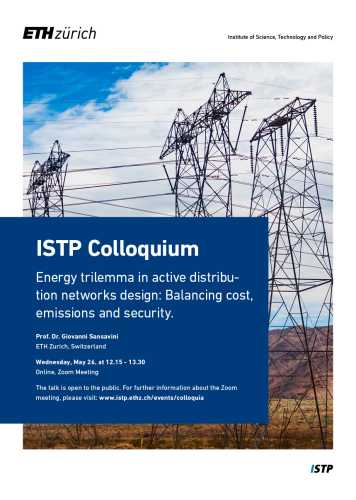Colloquium: Prof. Giovanni Sansavini
Wednesday, May 26, 2021, at 12.15 - 13.30
Online, Zoom | Sign up here
Energy trilemma in active distribution networks design: Balancing cost, emissions and security.

A drastic reduction in greenhouse gas (GHG) emissions is a complex challenge for all sectors from energy conversion to transmission, distribution and use. Electricity distribution systems will have to adapt to significant changes including the proliferation of photovoltaic (PV) generators and electric vehicles (EV). In most developed countries, such adaptations create a trilemma between cost, GHG reduction and security, i.e. the ability to absorb outages (reliability), and imbalances between generation and load (flexibility): While installing PV on rooftops or at solar farms has become economically viable in many cases, the intermittency of renewable generation requires additional flexibility to absorb the increased fluctuations in generated power. Furthermore, the integration of PV and EV can necessitate costly grid expansion to keep voltages and currents within safe limits. Active Distribution Networks (ADN) have been proposed as a solution to host large amounts of renewable energy while maintaining or improving reliability and flexibility. In ADN, distributed energy resources (DER) such as storage, (renewable) generators and flexible loads are coordinated to absorb fluctuations in renewable generation, to minimize costs and to defer grid expansion.
This talk investigates the trade-offs and optimal solutions in the distribution grid trilemma with a multi-objective ADN design optimization. The optimization determines the capacities of renewable generators, storages and grid expansion options, and dispatches all DER to meet GHG and reliability targets while minimizing investment and operational costs. Within the optimization, the installed DER can be combined with advanced communication, control and protection equipment to transform the ADN into a microgrid with islanding capability, maximizing the reliability. Furthermore, the ramping capability of all DER is harnessed to provide flexibility. Capacity to consume or provide additional power is offered by the ADN to the surrounding network at the point of common coupling, where they are interconnected. The resulting multi-objective Mixed Integer Linear Program is efficiently solved by combining Column and Constraint Generation decomposition with Surrogate Absolute Value Lagrangian Relaxation.
About Prof. Giovanni Sansavini
Professor Giovanni Sansavini is an Associate Professor of Reliability and Risk Engineering at ETH Zurich. Giovanni Sansavini’s research explores risk evaluation, resilience and reliability in relation to complex, critical energy networks and infrastructures. His approach is not limited to the physical aspects of the networks, but also covers evaluating the performance of the operators. Giovanni Sansavini is one of the few scientists in the world who are researching critical infrastructures in the energy sector.